- Essay Topic Generator
- Summary Generator
- Thesis Maker Academic
- Sentence Rephraser
- Read My Paper
- Hypothesis Generator
- Cover Page Generator
- Text Compactor
- Essay Scrambler
- Essay Plagiarism Checker
- Hook Generator
- AI Writing Checker
- Notes Maker
- Overnight Essay Writing
- Topic Ideas
- Writing Tips
- Essay Writing (by Genre)
- Essay Writing (by Topic)

Autobiography for Kids: Elementary & Middle School

Do you agree that kids’ autobiography is not a very common task? However, it is an excellent opportunity to reflect on one’s life. Each human being has something remarkable in their childhood to think about. That’s why we are unique and live unique life stories.
Even if it seems challenging in your situation or you find your life dull, we can assure you of the opposite! Our expert team has prepared a helpful guide that will help write any kind of autobiography for kids.
🤿 How to Write an Autobiography for Kids
🚸 autobiography for kids of different ages.
We’ve prepared this article to show that an inspirational autobiography for kids is what you can easily create yourself.
Let’s see which themes you can add to your kid’s autobiography.
Kids Autobiography Elements
We’re not going to provide you with a strict outline for your autobiography. Instead, we offer fundamental elements to set up your writing.
Start with early childhood – it is a significant period of formative years:
- Reflect on your background: your origins, ethnicity, family, and region.
- Share extra activities you were taking up, for example, attending ballet or music classes.
- Tell about your relationships with people around you: parents, grandparents, your peers in a kindergarten, and neighbors.
- Your interests and hobbies can be another exciting topic to elaborate on.
- Speak about any things you liked or disliked doing.
Embrace your culture – it indeed has some interesting details:
- Tell about everyday rituals typical to your culture.
- Give an example of traditional food served in your house.
- Describe your favorite holidays and how you celebrate them.
School experience – no matter if you are in the 3rd or 6th grade:
- Discuss your first experience with school.
- Tell how you built up relationships with teachers and fellow students.
- What were your most and least favorite subjects?
- Describe your classmates and what were your favorite games.
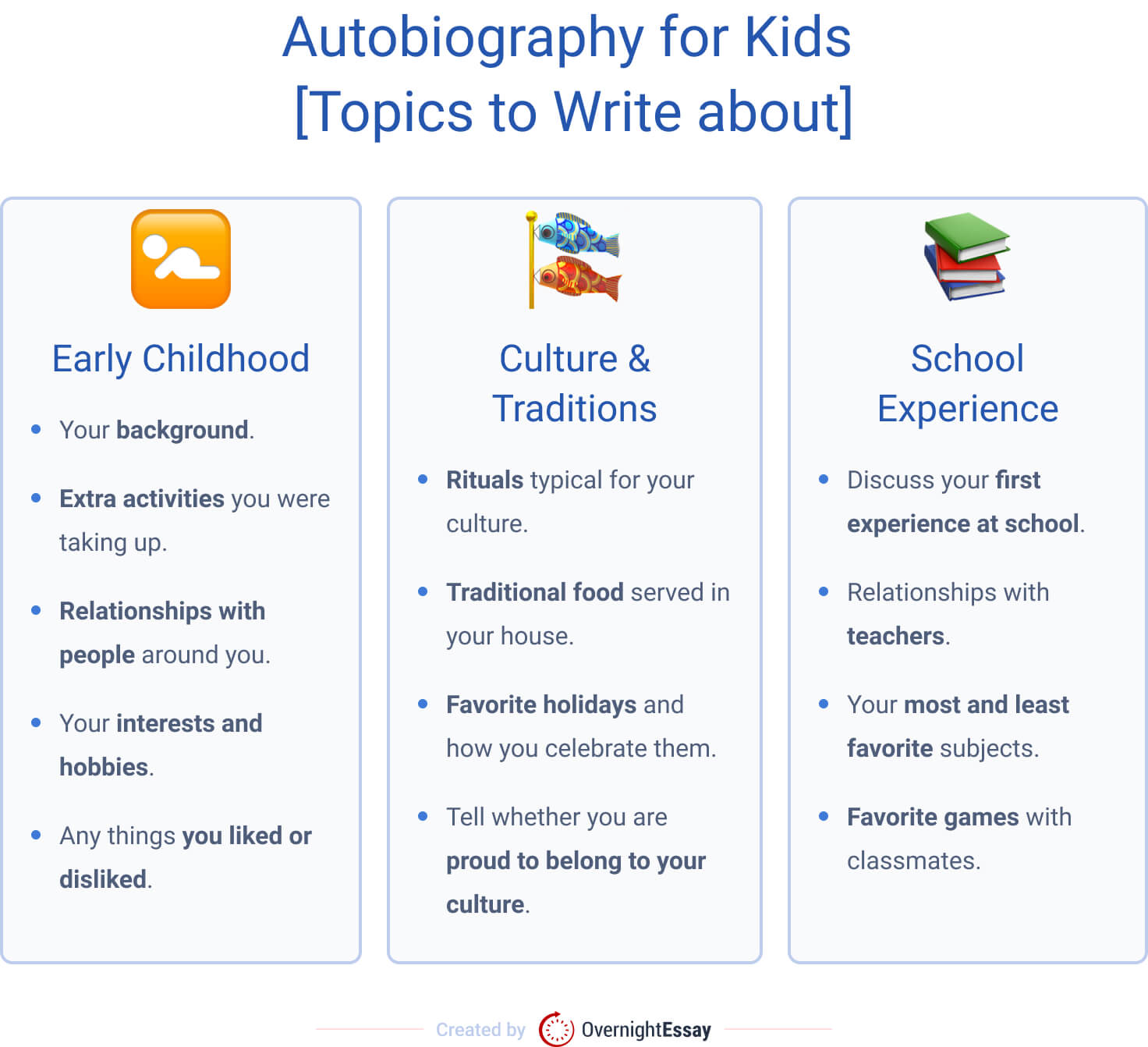
Tips for Writing an Autobiography for Kids
Some fundamental principles for achieving a good kids’ autobiography include:
Indeed, each of us can find something interesting in life to share. However, the younger you are, the less experience you have.
Here are some ideas for kids of different ages to assist them in writing an autobiography.
Autobiography for Elementary Students
This one is meant for kids from 6 to 11. Their autobiographies can focus on the following:
- Introduce yourself: who are you? What background do you have? Describe your family.
- You can dive deeper into your past. For example, you can share your experience in kindergarten and how you interacted with peers and teachers.
- Make a review of your interests: perhaps, you take up some extra activities. That can help reveal your personality.
- The excellent idea is to share your thoughts on your study at school. Do you consider yourself a good student? What do you find challenging?
- Concluding your autobiography, share your emotions after completing the task.
Autobiography for Middle School
If juniors write their autobiographies, then it’s even easier for 12-year-olds. If you have already entered middle school, add up the following things to your autobiography:
- To start your autobiography, introduce yourself and give a nice insight into your personality and origin.
- Reveal some remarkable details about your childhood and elementary school years.
- Think of some challenges you were going through in your life. Tell what you have learned from these situations.
- Some information about your relationships with the family will also fit your autobiography.
- Elaborate on the idea of how autobiography writing contributes to your understanding of yourself. These reflections were fruitful for you, weren’t they?
Try our exclusive and free essay topics generator if none of these ideas is close to what you want to write. It will help you develop an excellent idea for the autobiography assignment and any other written task. Save in bookmarks!
🧸 Autobiography Examples for Kids
Now we suggest getting acquainted with our short autobiography samples for elementary and middle schoolers. Read them for inspiration, and go for your own story!
#1 Example. 3rd Grade Autobiography
My name is Williams. I was named by my grand grandfather, who fought in Civil War for the Republican Party. I also have two siblings: an elder brother George and a small sister Lilly. I was born on April 26, 2012, in Sparks, Nevada. I’m nine years old now. I like going to school because I have many friends here. My parents tell me I’m a very communicative boy, which is true! I enjoy making new friends around. One of my first memories as a small kid is spending my summers in Texas at my grandmother’s place. She had a lovely farm in Dallas, and it was huge fun to be around her cows and chickens. My brother and I would play there a lot. Since then, I have truly loved animals. I have a dog now. He’s called Dodge, and I walk with him on Sundays in the park by our house. My favorite thing about school is music lessons. And a canteen. I also see my piano teacher twice a week. I reckon I’ll become a world-known pianist once I grow up. Generally, I study well, although I find math challenging for me. But I plan to master it too because I’m used to achieving my goals!
#2 Example. Autobiography for Middle School
I’m Jenny Maria Stevenson, and I am thirteen years old by now. I had my birthday last week, on October 14. I was born to a surgeon and a photographer. My mother takes stunning photos! My family came to Florida from Wisconsin when I was two years old. Living in Orlando, I cannot imagine it any other way, so I am happy my parents moved 11 here eleven years ago. I had a happy childhood because my mom and dad pampered me and cared about me a lot. I’ve been attending ballet classes since five, and I’m not going to quit because I genuinely love it. Ballet fills my life with inspiration and joy. I am also quite competitive. I realized it when I participated in a Miami ballet contest among girls a couple of years ago. When I won the first prize, I felt ultimate bliss. That makes me practice much and set new goals. However, I’m not into active socializing. I’m more like an introvert. I prefer to spend my time hitting on books and working out. Speaking of books, I love to study. I am a fan of literature, and my teacher is fantastic. We get along well, and that motivates me.
What do you think?
Which part of your life is the most interesting to share?
We hope our mini-guide inspired you to write a first-class autobiography for elementary or middle school.
Good luck, and remember, we are always ready to help!

- Character Traits
- Compare and Contrast
- Read Alouds
- Point of View
- Reading Response Ideas
- Summarizing
- Text Features
- Text Structures
- Find the Fib
- Reusable Ideas
- Disclosure Policy
- Lifetime Access
- 9 Low Prep Ideas
- Opinion Writing Prompts
- Student Gift Ideas
- Writing Ideas
- Party Ideas
- Countdown Ideas
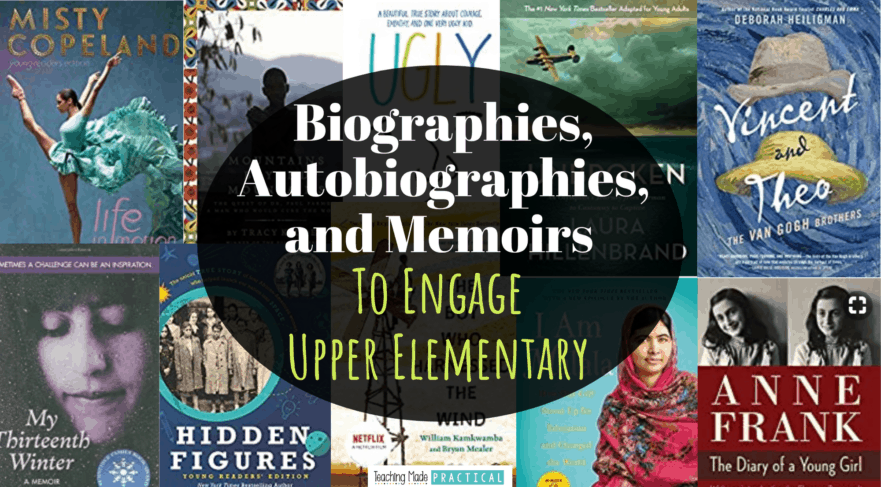
Best Biographies, Autobiographies, and Memoirs for Upper Elementary
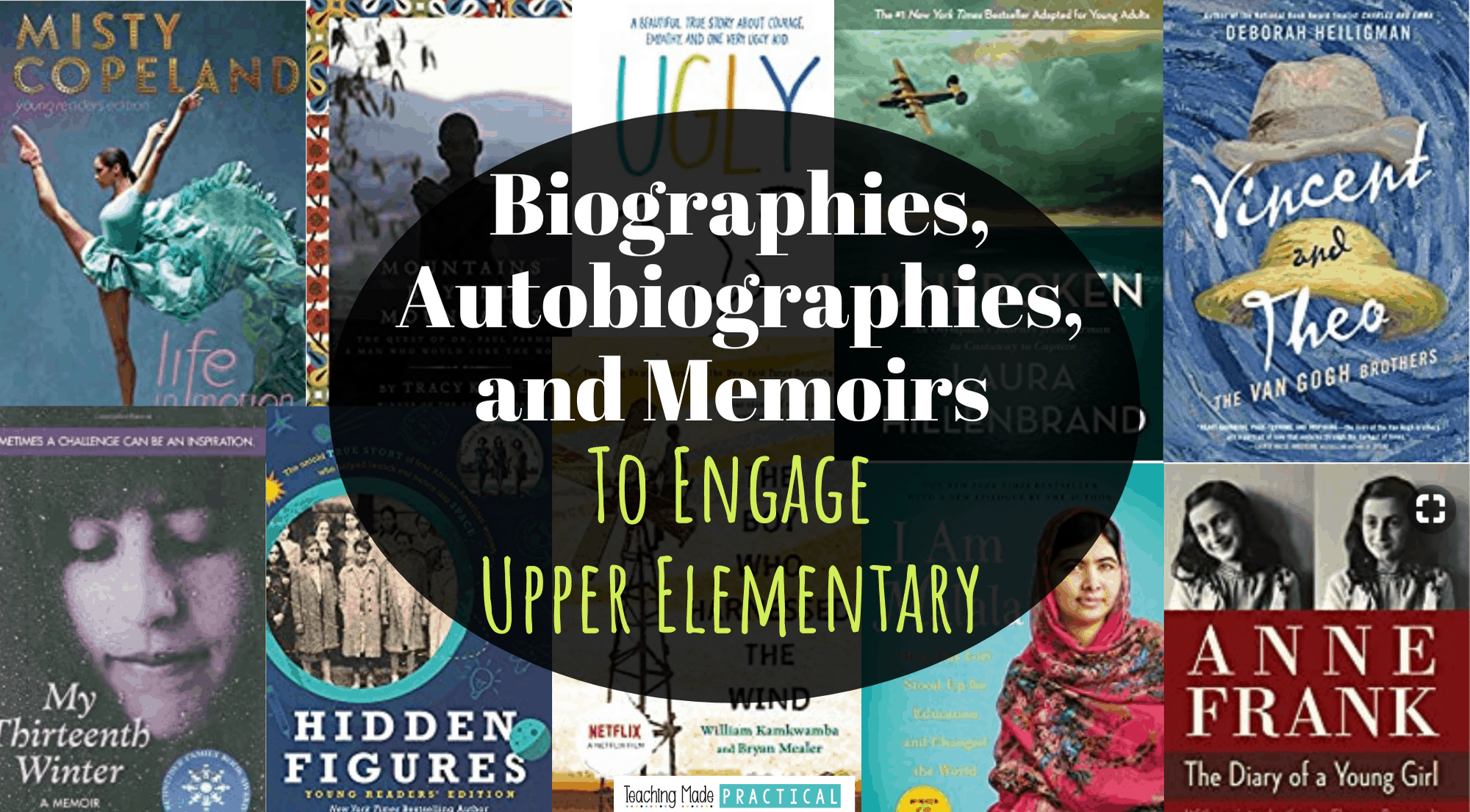
3rd, 4th, and 5th grade students don't often automatically grab biographies and autobiographies off the classroom library shelf. But the inspiring biographies below will have your upper elementary students begging for more!
Written by guest blogger Cindy Koopmans
In my classroom I’ve often found that biographies, autobiographies, and memoirs are a bit of a hard sell. Besides selecting only the best nonfiction books for my classroom shelves to begin with, this is how I’ve made it work...
Tips for Encouraging Students to Read Biographies, Autobiographies, and Memoirs
When students are looking for a new book to read, I go to the shelves and hand pick a stack of books for them to peruse. I’ll start the process by asking them what they’ve read lately and what they liked about those books. This strategy works because it is built on choice and trust. I’m enthusiastic about books and I never force a book on a kid. They get to choose what to read.
And when that happens, the conversation I have with one of my lovies goes something like this: “Mrs. K. This really happened? This story is like, for real?”
Me, “Yup.”
This is the truth: no matter who we are or how old we are, we are always looking for someone to light the way forward on this dark road called life.
Even the most jaded of students have the propensity to be inspired by the stories of people who have survived and thrived.
And that’s why it is so critical to give our students the gift of great nonfiction and allow them a glimpse into other people’s worlds. When we see how other people navigate the not insubstantial bumps in their personal roads it gives us hope.
So here you will find a nicely balanced list of great nonfiction books that are tried and true winners for upper elementary students. There is great variety in this role call. I’ve included books written about or by creatives, trailblazers, and a few so-called “ordinary” people, who when called upon by fate, did not back down. They met the challenges they faced head on and triumphed.
These people found themselves in extraordinarily difficult and, in some cases, harrowing life situations. The stories are unique, multi-faceted and...well...true!
As an added bonus, you can trust that these nonfiction books are incredibly well-written.
Sometimes, just to hook some of my more reluctant student readers, I take a minute out of our precious instructional time. I’m not doing anything too fancy, I simply introduce a new book and read the first page or two enthusiastically.
If I’m with a particularly apathetic class I’ve been known to climb up on a chair and use lots of over the top hand gestures. Hey! Whatever it takes, right?
Anyway, I’m never sorry about taking the time because there is absolutely nothing more exciting than hearing numerous kids blurt out an enthusiastic, “I want to read that one!”
What just happened here? A waiting list? Awesome.
These are good books. Many of these books are showing the wear and tear of being well-loved in my fifth grade classroom. Others have gotten a thorough vetting before they made this list and are now on an Amazon wish list until I get two nickels to rub together. You and your students will find them to be deeply satisfying reads. Get ready for a cupcake shop moment, because you are not going to know which one to pick!
12 Biographies, Autobiographies, and Memoirs for 3rd, 4th, and 5th Grade Students
Anne frank: the diary of a young girl by anne frank, b.m. mooyaart (translator), eleanor roosevelt (introduction).
It is July 6, 1942, the setting is Amsterdam, and Anne Frank has just received a diary for her birthday. The rest is history.
Every year I have at least one student who loves Laurie Halse Anderson's historical fiction books. If you have students like that in your class, then Anne Frank will absolutely blow their minds. Introduce them to this classic read, then share the link to the full length movie.
Some books introduced to students are gifts that they will remember the rest of their lives. Be that teacher that gives that gift. Here I just want to say thank you to Mrs. Barclay. I still have my original copy.

Unbroken: An Olympian's Journey from Airman to Castaway to Captive by Laura Hillenbrand
This book begins with an excruciating description of three men who are floating on a raft in the middle of the Pacific Ocean. Suffice it to say that sharks are predominant in the narrative of the first chapter. Fifth grade boys? Gotcha. Add to the sharks stuff the fact that the main character, Louis Zabarelli, is a former Olympian and you just set the hook.
This recommendation of the young adult adaptation of Louis Zabarelli’s story, but that shouldn’t be a cause for hesitation. This book graces the shelf of my classroom library, but it isn’t on the shelf very often. That and it’s worn condition testifies that Louis Zabarelli’s story does hold appeal for upper elementary aged students. I’ve included the movie trailer for you in case you want more evidence.

Hidden Figures by Margot Lee Shetterly
This is another worn book in my classroom library. In fact, I have three copies because it has been that popular.
You can find some extra resources here if you’re that smart teacher that seeks to intertwine some science lessons into your literature. If you haven’t seen the movie that was released a few years ago, you can watch the trailer here.

Save time and stress this school year with these Nonfiction Reading Response Activities that can be used over and over throughout the school year with ANY nonfiction text.
3rd, 4th, and 5th grade students will respond through reading, writing, poetry, speaking, listening, drawing, interviewing, and more. This is a must have for any upper elementary teacher that does not want to have to constantly recreate the wheel.
The Boy Who Harnessed the Wind by William Kamkwamba
You may want to watch the movie on Netflix, but don’t tell your students it is there until after they read the book. (And you could use some of these questions and activity ideas for comparing movies to books.) Another recommendation from my classroom shelves.

I Am Malala by Malala Yousafzai with Patricia McCormick
Look up the word inspiring in the dictionary and you may find Malala Yousafzai’s picture there. Malala Yousafzai is internationally famous because she and her family stood up to the Taliban’s edict that girls were not allowed to receive an education. Malala’s father taught her not to back down from what she believed in, even though she knew she was in danger, Malala continued to attend school. As a result, Malala almost lost her life when she was shot riding the bus home from school.
Here’s a short video about how Malala, the youngest ever winner of the Nobel Peace Prize at the age of 17, continues her mission to make a difference in the lives of young women around the world.
A biography of Malala also made this list of books about overcoming obstacles.

Ugly by Robert Hoge
Do we have a choice in what we allow to define us? Robert Hoge’s memoir answers this question with a resounding, “Yes!”
Bullied and misunderstood because of a facial tumor and other disabilities he was born with, Robert Hoge teaches us how to live wholeheartedly and fearlessly despite how we might be judged and treated by the world. This is the very best kind of story, honestly and simply told by the person who lived through it all.
Robert was born with disfigurements that made him a baby only a mother could love, except his own mother didn’t want him and still, he made it. I know I have students who need to hear his story and I’m sure you do too.

Mountains Beyond Mountains by Tracey Kidder
I was beyond excited when I learned that Tracey Kidder’s book about Dr. Paul Farmer and his work with Partners in Health had been adapted for young readers.
Tracey Kidder shadows Dr. Paul Farmer whose mission is to provide quality healthcare to the most economically disadvantaged people in the world’s most impoverished populations. Dr. Farmer’s father exemplified altruism and expected his children to participate in his passion.
Even though the family didn’t have money, Dr. Farmer made a decision to attend college and pursue medicine. It was a high school guidance counselor that helped him take the first steps.
This is a book that I challenge students to read, because it’s...well...challenging! But a student who choses to tackle it has not been disappointed.

My Thirteenth Winter by Samantha Abel
Samantha Abel was a straight A student with a secret. She couldn’t remember her locker combination or tell time. The disconnect caused her to suffer from anxiety attacks. In her thirteenth winter, Samantha found the strength and the courage to confront her problems. Consequently, Samantha learned that she had a learning disability called dyscalculia. Once the disability is discovered and addressed, Samantha’s life begins to change.
As teachers know, learning disabilities are a discrepancy between intelligence and academic struggle. It is in that often agonizing struggle that a learning disability is forced to the surface. We know what they are, but we don’t really know what causes them.

A Long Walk to Water by Linda Sue Park
Linda Sue Park lays out the story in two distinct sections, intermingling fiction and nonfiction. The book tells the story from the point of view of a young girl, Nya, as she walks all day long to procure water for her family’s needs: hence the title. But it is Salva’s point of view story that is truly central to the book. Salva is one of the “Lost Boys” of Sudan who is walking to escape the violence and constant threat of being conscripted into the Sudanese army. Spoiler...the two stories come together at the end of the book.
I spend a lot of time convincing those kiddos who read ahead not to give away the ending and wreck the book for their classmates. This link will take you to a short video about Salva.

Life in Motion: An Unlikely Ballerina by Misty Copeland
Misty Copeland is the first African-American principal dancer in American Ballet Theatre history. Adapted for young readers, the adult version of this book made the New York Times best-seller list. This is another excellent autobiography I’ve had to purchase in multiples because it is in demand with my girls.
Misty Copeland’s grit and determination, added to her passion, led her to a successful career in dance. It all began so simply.
She writes, “My family didn't have very much money, so ballet wasn't even on my radar; I just found it randomly when I was 13 at a Boys & Girls Club. We were practicing on a basketball court in gym clothes with some old socks on. Even though it terrified me at first, I found that I really liked it.” Find something you love and pursue it with all your heart. Yes.
Check out these other inspirational biographies of African-Americans.

Lion: A Long Way Home by Saroo Brierley
An incredible true story that just proves the point that life is often stranger than anything anyone could make up in a million years.
His book chronicles his struggle to remember where he came from and to reconnect with his family, which he does when he is 25 years old. You can watch a trailer for the Hollywood Version here.

Vincent and Theo: The Van Gogh Brothers by Deborah Heiligman
Vincent’s younger brother Theo is the pragmatist in the relationship, but still an art lover—he works as an art dealer, which on the face of it could be immensely helpful for Vincent. But Vincent’s artistic style, that of the Impressionist school, is simply not in fashion and Theo can’t change that fact.
Despite their personality differences and all the drama Vincent brings to the relationship these brothers remain loyal to the core. This is a beautiful and touching story of brotherly love and devotion.
You’ll find it special as a direct result of Deborah Heilgman’s efforts to get the details right: she carefully gleaned information from more than 600 letters Vincent wrote to his brother Theo over his lifetime.
Deborah Heiligman is the award winning author of Charles and Emma and many other books for children and young adults.

Find more book suggestions for 3rd, 4th, and 5th grade students here.
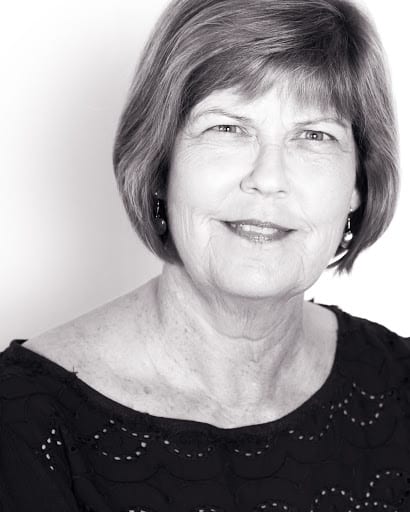
Never Stress Over Sub Plans Again!

Make copies, find a fiction book, and you'll be ready for any emergency that comes your way!
Leave a Reply Cancel reply
You must be logged in to post a comment.
- Primary Hub
- Art & Design
- Design & Technology
- Health & Wellbeing
- Secondary Hub
- Citizenship
- Primary CPD
- Secondary CPD
- Book Awards
- All Products
- Primary Products
- Secondary Products
- School Trips
- Trip Directory
- Trips by Subject
- Trips by Type
- Trips by Region
- Submit a Trip Venue
Trending stories

Top results

- Features Of An Autobiography Resources For Ks2 English
Features of an autobiography – 6 of the best resources for KS2 English
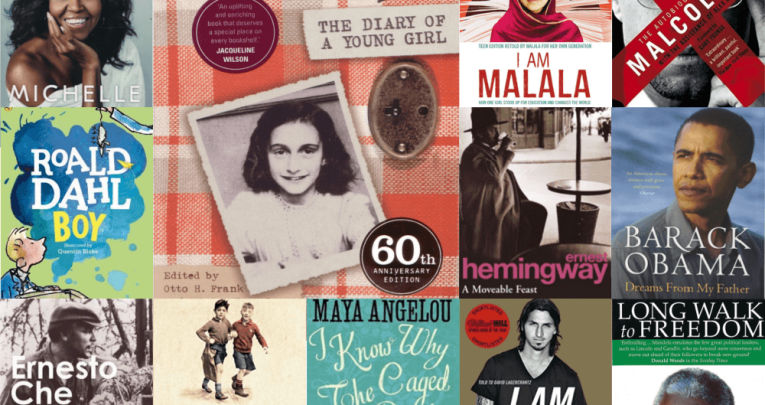
Getting kids to talk about themselves shouldn't be hard, but getting them to create good autobiographical writing, you might need these activities, ideas, templates and worksheets…

Back before selfies and Instagram feeds the way to tell your own story was to write it.
And sure, your average Key Stage 2 student probably won’t have accumulated enough life experience for the next Long Walk to Freedom , but they can probably do a better job than half the ‘celebrity’ books that hit the shelves in the run-up to Christmas.
And that’s before you’ve even started with these great resources.
1 | Characteristics of an autobiography

This nifty little resource not only includes the great quote in the pic above, it has a good summary of autobiographical writing, explains where the word ‘autobiography’ comes from, and has a few good examples of autobiographical passages to boot.
Check it out here.
2 | Roald Dahl book topic
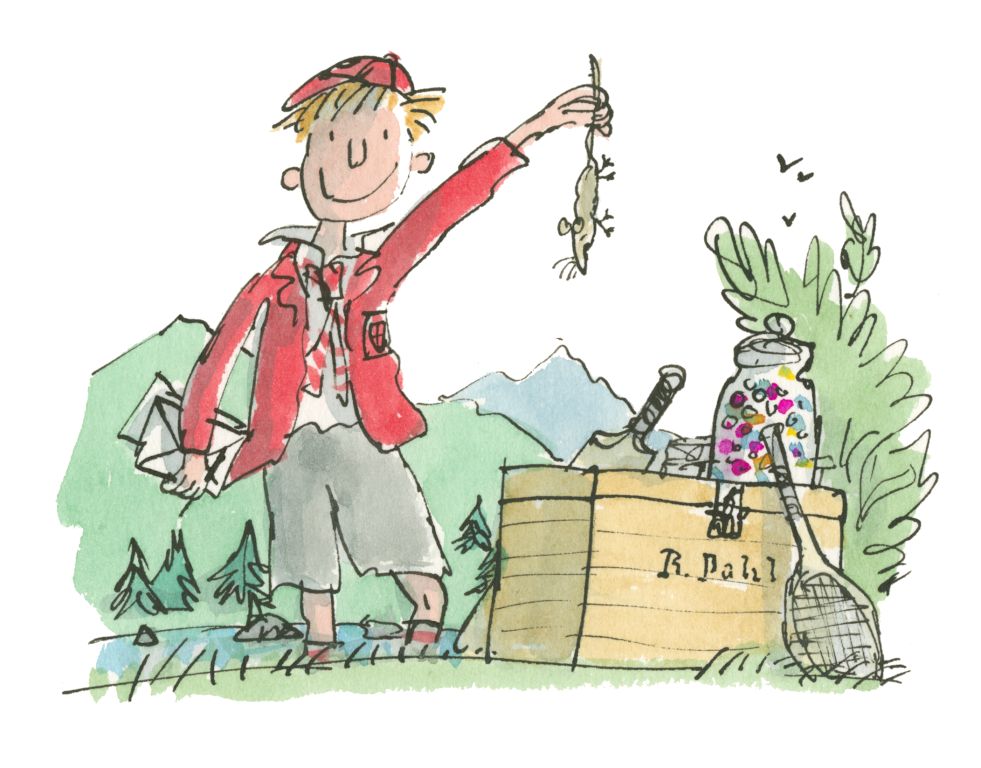
The Great Mouse Plot was one of the stories from Roald Dahl’s childhood autobiography, Boy , where he and his friends pranked the local sweet shop owner by placing a dead mouse in a jar of sweets.
They were duly caught, and caned by their headmaster.
Carey Fluker Hunt’s book topics explores using memories for engaging creative autobiographical writing.
Get this resource here.
3 | Super hero autobiography example
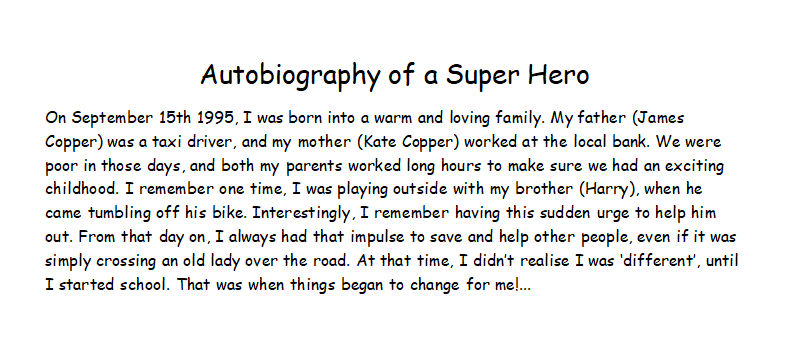
Head on over to Literacy Wagoll’s Biographies and Autobiographies section for a collection of free example texts, including this superhero autobiography.
No doubt your students are more than familiar with comic book movies and have seen countless origin stories, so they should be able to write one for their own created superhero.
It’s the perfect writing hook, coming up with a character and how they got their superpower.
And if you want to actually watch a superhero movie, the first Spider-Man film (AKA the best one) from Sam Raimi is an excellent example (although it does have a 12A rating, so maybe just show clips or talk about it).
It’s opening line? ‘Who am I?’. It’s closing line? ‘Who am I? I’m Spider-Man’. Perfect.
In the meantime, download superhero autobiography example here.
4 | Autobiography checklist
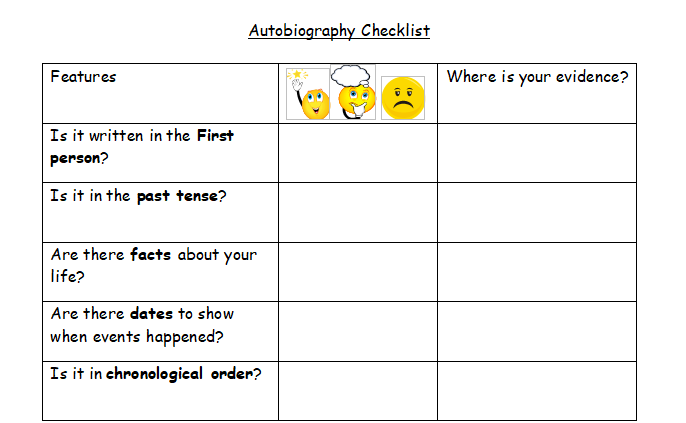
Once your pupils get to writing an autobiographical piece, this checklist might come in handy.
It has the basics like ‘Is it written in the 1st person?’ and ‘Is it written in the past tense?’ but also things like ‘Are there dates to show when events happened?’ and ‘Is there any emotive language?’.
Plus, there’s a column on the sheet where they can show evidence that they’ve included all of these elements.
This resource also includes a biography checklist should you need that too.
Click here to download.
5 | The life of Nelson Mandela
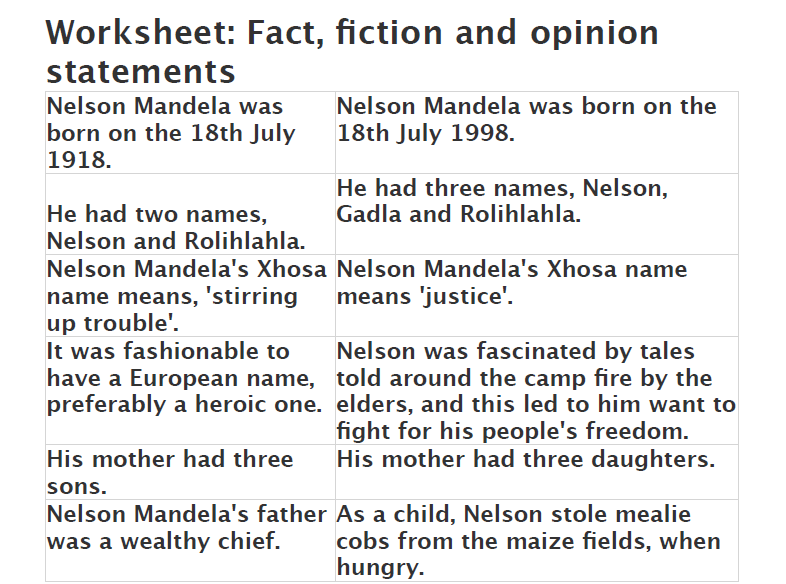
This Oxfam set of resources for upper KS2 explores the life of Nelson Mandela and the differences between biography and autobiography.
They also provide ideas for discussing the difference between explicit and implicit points of view, and the differences between first and third person narration.
There are five lessons, all of which can be found here.
6 | Newspaper template
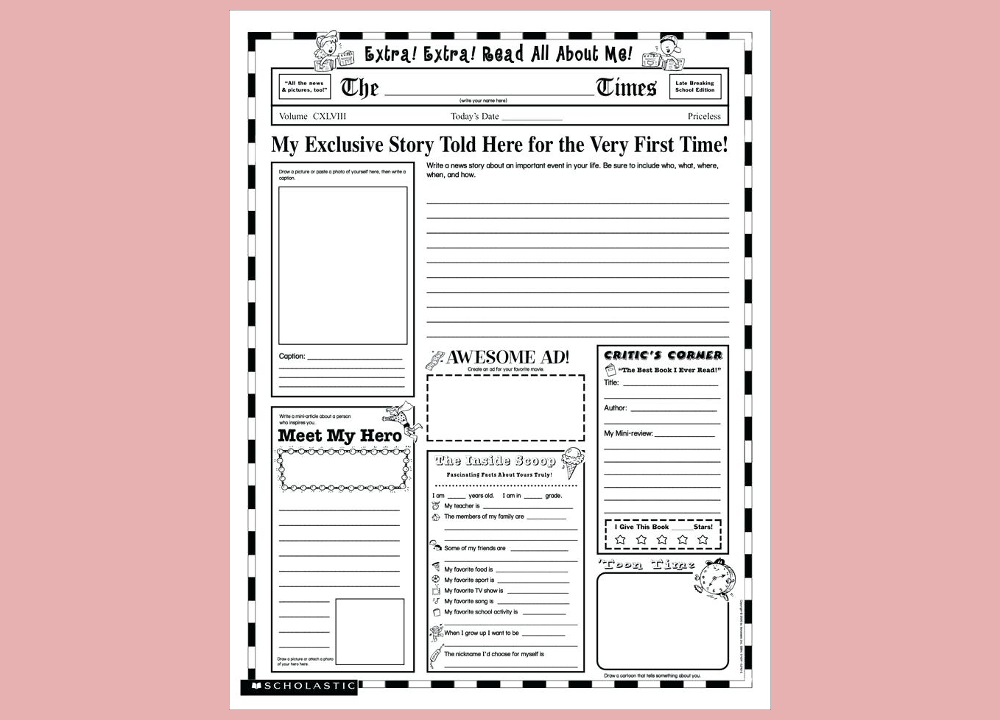
One for younger pupils, this newspaper-style template lets them write all about themselves, their likes and dislikes, their heroes and their hobbies.
Download it here.
Sign up to our newsletter
You'll also receive regular updates from Teachwire with free lesson plans, great new teaching ideas, offers and more. (You can unsubscribe at any time.)
Which sectors are you interested in?
Early Years
Thank you for signing up to our emails!
You might also be interested in...
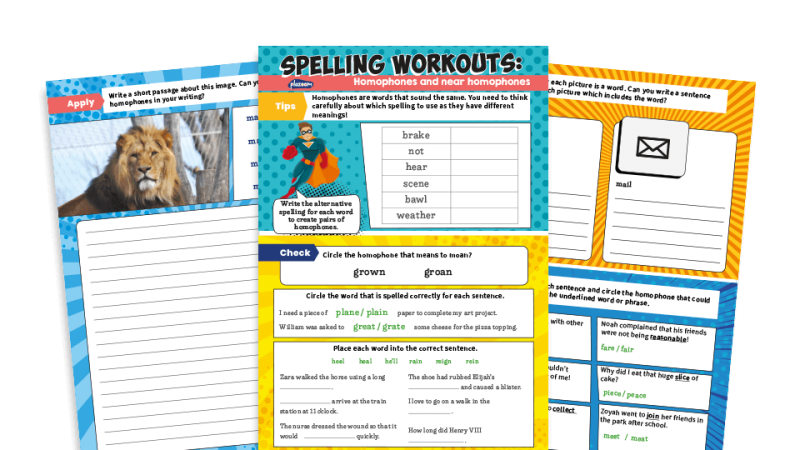
Why join Teachwire?
Get what you need to become a better teacher with unlimited access to exclusive free classroom resources and expert CPD downloads.
Exclusive classroom resource downloads
Free worksheets and lesson plans
CPD downloads, written by experts
Resource packs to supercharge your planning
Special web-only magazine editions
Educational podcasts & resources
Access to free literacy webinars
Newsletters and offers
Create free account
By signing up you agree to our terms and conditions and privacy policy .
Already have an account? Log in here
Thanks, you're almost there
To help us show you teaching resources, downloads and more you’ll love, complete your profile below.
Welcome to Teachwire!
Set up your account.
Lorem ipsum dolor sit amet consectetur adipisicing elit. Commodi nulla quos inventore beatae tenetur.
I would like to receive regular updates from Teachwire with free lesson plans, great new teaching ideas, offers and more. (You can unsubscribe at any time.)
Log in to Teachwire
Not registered with Teachwire? Sign up for free
Reset Password
Remembered your password? Login here

Telling a Story About Me: Young Children Write Autobiographies
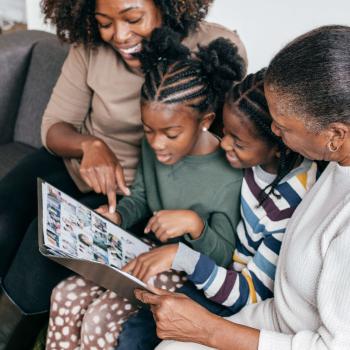
- Resources & Preparation
- Instructional Plan
- Related Resources
Developing ideas collaboratively, planning writing projects before executing them, and learning to compose sentences related to a specific topic are important skills for students to master. This lesson plan teaches these skills while drawing from the lives of first and second grade students who will write and publish autobiographies based on personal photographs. The lesson begins with the students working at home with their families to select and record relevant information about photos. Students then work in small groups and independently to create their autobiographies.
From Theory to Practice
- Autobiographical writing gives teachers a way to engage students and their families in literacy learning, creating a willingness to participate in literacy activities.
- Expanding students' knowledge of their community and themselves deepens their understanding of the reading and writing process.
When students write narratives about their own lives it helps them develop personal, social, and cultural connections.
Exploring their own life stories can provide a sense of direction and purpose for students that other forms of writing do not.
Common Core Standards
This resource has been aligned to the Common Core State Standards for states in which they have been adopted. If a state does not appear in the drop-down, CCSS alignments are forthcoming.
State Standards
This lesson has been aligned to standards in the following states. If a state does not appear in the drop-down, standard alignments are not currently available for that state.
NCTE/IRA National Standards for the English Language Arts
- 4. Students adjust their use of spoken, written, and visual language (e.g., conventions, style, vocabulary) to communicate effectively with a variety of audiences and for different purposes.
- 5. Students employ a wide range of strategies as they write and use different writing process elements appropriately to communicate with different audiences for a variety of purposes.
- 6. Students apply knowledge of language structure, language conventions (e.g., spelling and punctuation), media techniques, figurative language, and genre to create, critique, and discuss print and nonprint texts.
- 7. Students conduct research on issues and interests by generating ideas and questions, and by posing problems. They gather, evaluate, and synthesize data from a variety of sources (e.g., print and nonprint texts, artifacts, people) to communicate their discoveries in ways that suit their purpose and audience.
- 8. Students use a variety of technological and information resources (e.g., libraries, databases, computer networks, video) to gather and synthesize information and to create and communicate knowledge.
- 11. Students participate as knowledgeable, reflective, creative, and critical members of a variety of literacy communities.
- 12. Students use spoken, written, and visual language to accomplish their own purposes (e.g., for learning, enjoyment, persuasion, and the exchange of information).
Materials and Technology
- Photographs from home
- Writing and drawing tools
- Tape or glue for affixing photos
- Binding materials
- You Have to Write by Janet S. Wong (Margaret K. McElderry Books, 2002)
- Chart paper and a marker
- Transparencies and a projector
- Assessment Guide
- Note to families
- An Autobiography: Information About My Photos
- An Autobiography: Ideas for My Story
- An Autobiography: Planning My Story
- Autobiography page
- Cover sheet
- Dedication page
Preparation
Student objectives.
Students will
- Engage their families in the learning process by working at home to select photographs that represent aspects of their lives
- Formulate ideas for an autobiography by working collaboratively and independently
- Practice their writing skills by composing sentences in the first person using themselves as subject matter and revising the composed sentences into a story
- Participate in a literacy community by reading their stories aloud in small groups
- Invite families to school to share the published autobiographies of the students.
- Further develop students' autobiographical writing skills by using the Stapleless Book or the online ReadWriteThink Printing Press to have them write more about their lives.
Student Assessment / Reflections
Throughout this lesson, you may use the Assessment Guide to document observations of students in each of the five areas found in the lesson objectives: family participation, collaborative work, independent work, writing sentences, and reading aloud. There is also space to record other notes and observations. Some questions to ask when using the Assessment Guide include:
- Family Participation–How much did the family participate in this project? Did they send in appropriate photographs and complete the work that needed to be done at home? Was the work done when requested?
- Collaborative Work–How did the student collaborate with his or her peers? Did he or she make appropriate suggestions? How did he or she accept suggestions about his or her own work?
- Independent Work–How did the student work independently during the project? Did he or she follow directions? How well did he or she stay on task when working independently?
- Writing Sentences–How did the student do at composing and writing sentences for the autobiography? Are the sentences on topic with the photographs? Are the sentences grammatically correct? What resources did he or she use to spell and write words (asking a peer, asking a teacher, the word wall, the dictionary, or using phonetic spelling)?
- Reading Aloud–How did the student do when reading the autobiography aloud? Could he or she read it independently or was assistance needed? How was the fluency of reading aloud?
Add new comment
- Print this resource
Explore Resources by Grade
- Kindergarten K
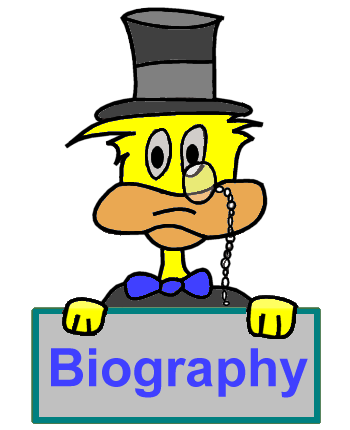
Biographies
Back to Ducksters Home Page
How To Write An Autobiography
Autobiography Examples
11+ Autobiography Examples: A Detailed Guide

People also read
Learn How to Write an Autobiography Step by Step
Basic Types of Autobiography Writing With Examples
Simple Autobiography Format for Students to Follow
Autobiography vs. Biography vs. Memoirs: The Differences & Similarities
Autobiography vs. Memoir - Differences & Similarities
How to Write a Memoir: Everything You Need to Know
Have you ever thought about telling your life story?
An autobiography is like a special book about you – your experiences, ups, downs, and everything in between.
But when it comes to autobiography writing , putting it all into words, it can feel a bit tricky, especially for students like you.
In this blog, we're here to help you understand what an autobiography is all about and make it easier for you to write one with the help of examples.
We'll dive into practical examples and autobiography templates to help you see how it's done.
So, let's dive in!

Tough Essay Due? Hire Tough Writers!
- 1. Memoir Vs Autobiography Example
- 2. Autobiography Outline Examples
- 3. How to Write an Autobiography - Examples
- 4. Autobiography Examples for Students
- 5. Personal Autobiography Examples
- 6. Famous Autobiography Examples
Memoir Vs Autobiography Example
Memoirs and autobiographies both delve into personal experiences, but they have their own styles and purposes.
Let’s jump into example to see what is the actual difference between memoir and autobiography:
Memoir Vs Autobiography Example PDf
Autobiography Outline Examples
Any academic or professional writing needs to follow a proper format to organize the information. And an outline is the best way to follow the proper format. It helps you organize your information and structure your data into a proper format.
Here are some autobiography outline examples to help you learn the basics of the autobiography format .
Autobiography Outline for College - Example
Autobiography Sample Outline
How to Write an Autobiography - Examples
As we have mentioned earlier, there are as many stories as there are people on earth. Each of the stories is different from the others; no two of them could be the same.
How you present your ideas really matters. That's why using the right strategies and the correct format is essential to make your writing creative.
It is important to know the difference between autobiography and biography . These examples will help you learn how to start an autobiography that leaves a good impression on the reader’s mind.
Autobiography Sample PDF
Writing an Autobiography - Example
Autobiography Examples for Students
An autobiography is your life story. If your teacher tells you to write one, they just want to hear about your life. Even if you think your story isn't super exciting, following the structure can make it work better.
These autobiography examples for students will help you understand how you can properly format the autobiography.
Autobiography Examples for Kids
School is a time of discovery, and what better way to explore your own journey than through the lens of an autobiography? Here are some great autobiography examples crafted specifically for kids.
Autobiography Examples Ks2
Autobiography Examples For Grade 7
Autobiography Examples For Class 6
Short Autobiography Example for Students
Here is a sample of a short autobiography for you. Give it a good read and learn how to write an excellent short autobiography.
Short Autobiography for Students - Example
High School Autobiography Example
Check out this sample and learn to write an incredible autobiography for high school students.
High School Autobiography - Example
Spiritual Autobiography Example for College Students
Spiritual autobiographies give a glimpse into the spiritual person's life. Have a look at the following sample spiritual autobiography and give it a good read to learn more.
Spiritual Autobiography for College Students - Example
Cultural Autobiography Examples
Here is a sample of a cultural autobiography that contains detailed information on culture. Have a look at the sample to know more about it.
Cultural Autobiography Examples
Funny Autobiography Examples
Autobiographies are thought to be boring and mundane, but that is not the case. You can make an interesting story, as well as funny. Learn to write a funny autobiography by this example.
Funny Autobiography Examples
Educational Autobiography Example
Here is a sample educational autobiography that will help you formulate an effective and inspiring autobiography.
Paper Due? Why Suffer? That's our Job!
Social Class Autobiography Example
Writing a social class or sociology assignment could be a bit difficult. This sample will help you work on yours easily.
Rambling Autobiography Examples
Rambling autobiographies are like a casual conversation with a friend, where stories unfold in their own unique way.
Let’s jump into some fascinating examples about this type of autobiography:
Personal Autobiography Examples
Personal autobiography or personal narrative essay provides a complete picture of the author’s life story. The following personal autobiography demonstrates how to write a personal narrative autobiography.
Personal Narrative Autobiography - Example
Autobiography Examples for Students About Yourself
Famous Autobiography Examples
Autobiographical essays are usually about famous people or historical figures. Just as a renowned autobiography of Benjamin Franklin tells us about his life, his unfinished records, his accomplishments, etc.
Below are some examples of famous autobiographies for your better understanding:
Famous Literacy Autobiography Example
Famous Autobiography - Sample
All in all, we have explored different examples, like understanding what makes memoirs different from autobiographies and exploring rambling ones. These examples are like guides to help you tell your own story and maybe inspire others on your writing journey.
So, go ahead, give it a try, and have fun telling your unique tale.
And if you need assistance you can always reach out to us!
Our writers can write outstanding autobiography for you! All you have to do is place your " write an essay for me " request and we'll create your custom autobiography in no time!

Write Essay Within 60 Seconds!

Dr. Barbara is a highly experienced writer and author who holds a Ph.D. degree in public health from an Ivy League school. She has worked in the medical field for many years, conducting extensive research on various health topics. Her writing has been featured in several top-tier publications.

Paper Due? Why Suffer? That’s our Job!
Keep reading

- International
- Schools directory
- Resources Jobs Schools directory News Search

Writing an autobiography planning, example and task - great for distance, home or online learning
Subject: English
Age range: 7-11
Resource type: Lesson (complete)
Last updated
30 September 2020
- Share through email
- Share through twitter
- Share through linkedin
- Share through facebook
- Share through pinterest

Writing an autobiography? A great task to set children and encourage them to write, particularly for distance, home or online learning. The powerpoint explains what the children need to write about and includes a planning mind map. There is an example autobiography to help inspire children as well as a document to help structure their autobiography.
Creative Commons "Sharealike"
Your rating is required to reflect your happiness.
It's good to leave some feedback.
Something went wrong, please try again later.

laurajanecutler
Great, thanks for supporting my tutoring lesson with this resource
Empty reply does not make any sense for the end user
Report this resource to let us know if it violates our terms and conditions. Our customer service team will review your report and will be in touch.
Not quite what you were looking for? Search by keyword to find the right resource:

Teaching Students to Write Biography Reports
Biographies are many students’ first glimpse at history. It is one of my favorite units to teach every year. It is a great opportunity for students to read, research, use technology, and write!
If you’re teaching students to write biography reports this year, then check out how I like to break it down!
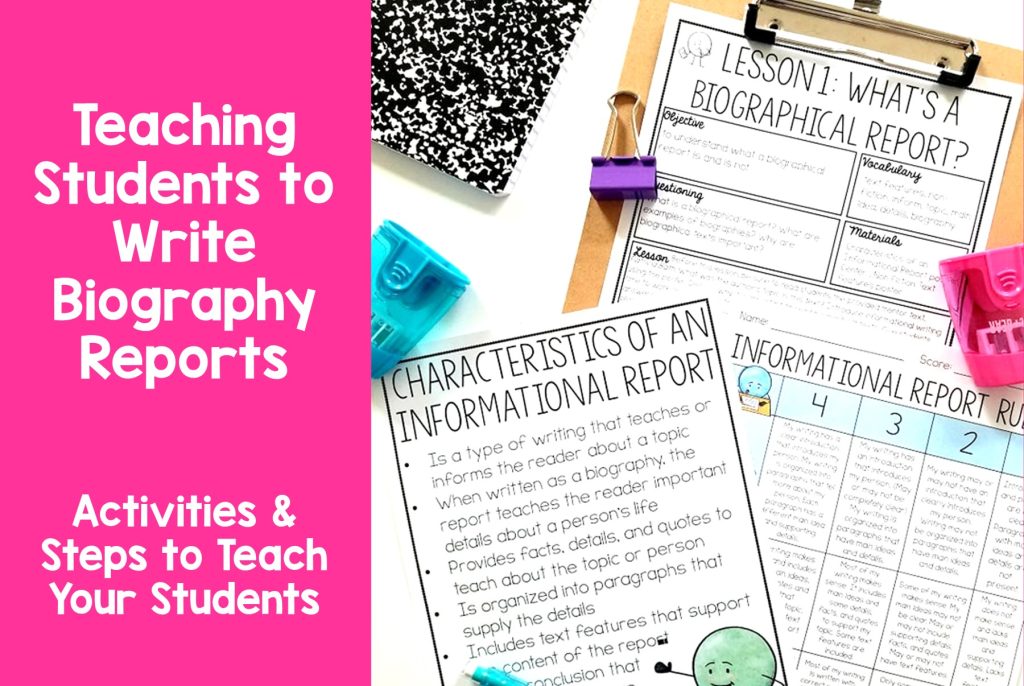
Breaking Down Writing a Biography Report (Grades 2-5)
Writing these types of reports is part of the Common Core writing standards for Grades 2-5 as well as many other states’ standards. There are several steps to take as you teach your students to write a biography report.
The first step ALWAYS: Introduce Biographies
Before I even begin to teach my students how to write a biography, I like to read several from our school library.
For second and third grade students :
- Have several biographies in the classroom and give students time to explore the books. Then discuss: What did you notice about all these books? How are they the same? How are they different?
- Discuss genre and introduce biographies.
- Then, I would read them biographies about many different people.
For fourth and fifth grade students :
- Make a class anchor chart discussing what you already know about biographies. Look for gaps in understanding, and make sure students know the main characteristics of a biography.
- Then, read several different biographies about the same person with a focus on the different information each biography shared, as well as what information was the same. Did all of the biographies have the characteristics we listed on our anchor chart?

It is important to make note of the characteristics that biographies have so that when students write their own, they already have an understanding of how they are written!

Once students have been exposed to biographies, you can begin to teach about writing them.
Discuss Text Structure of Biographies
Depending on the grade you teach, you may not necessarily call it “text structure,” however it is important for students to understand that most biographies are written in a chronological/sequential way.
Since we are writing about someone’s life, it wouldn’t make sense for the report to be out of order.
While we go over this, I like to create a timeline with my students.

If you are using my biography writing units, I recommend:
- Using the mentor text to create a timeline of the subject’s life. You can do this on the board or on chart paper.
- Use the research text to create a timeline of the subject’s life (this is the person the students will write about, and a text is included in the units). For older students, you may choose to have them fill out the timeline on their own.
How to Write an Engaging Introduction for the Biography Report
At the beginning of the report, students should write an engaging introduction that includes one (or both) of two main components.
The introduction should include one (or both) of these components:
- Introduce the subject with their full name and birth information or
- Briefly preview what they are most famous for

Practice writing a variety of introductions and have students choose the one they like the best. ( TIP: Model some poorly written introductions as well , and discuss why those are not a good fit!)
Crafting the Body Paragraphs of the Biography Report
When teaching your students to write biography reports, it is important to explain to them what the body paragraphs should include.
The body paragraphs should include the major events in the person’s life.
Read over the body paragraphs from your mentor text and discuss what was included and what was not included. What was included in the timeline you created? What did you leave out?

You can make a T chart with your students and discuss what are major events in your own life, and what are not.
Writing a Conclusion for the Biography Report
Most conclusions in a biography end with the person’s death.
While this can be noted, it’s important for students to understand that they shouldn’t just end their report with “and then they died in 1894”. It is more important for them to end their report with the legacy of the person.
To help students understand what a person’s legacy means:
- Review and write legacies of other famous individuals from biographies you have read to your class.
- Ask them what their person is most known for (and review their introduction).
- Ask them how this person has impacted other people.
If you are looking for resources for teaching your students to write a biography report, check out my writing units.
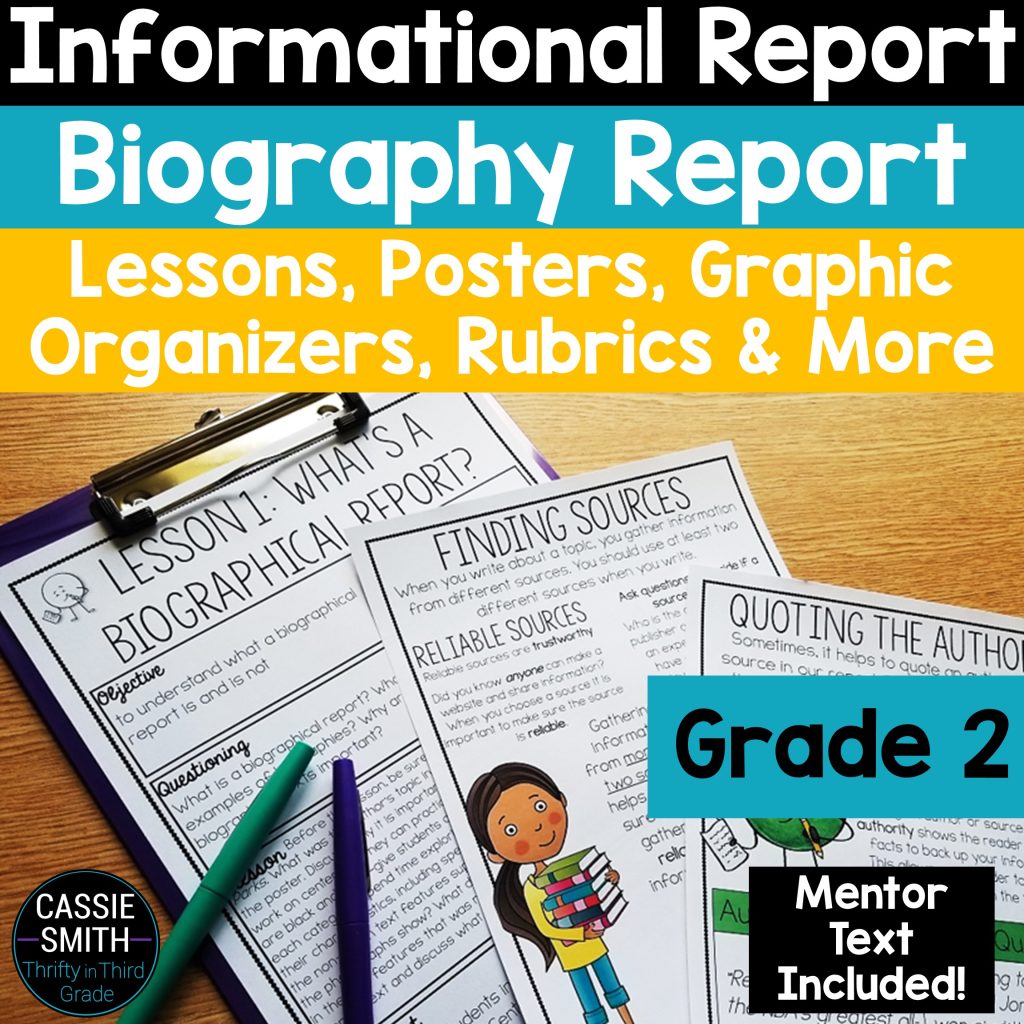
These units also include a Google Slides option so you can teach the whole unit digitally!
Preview the grades 2-5 biography writing units here:.
Get resources for teaching your Grades 2-5 students to write a biography report here.
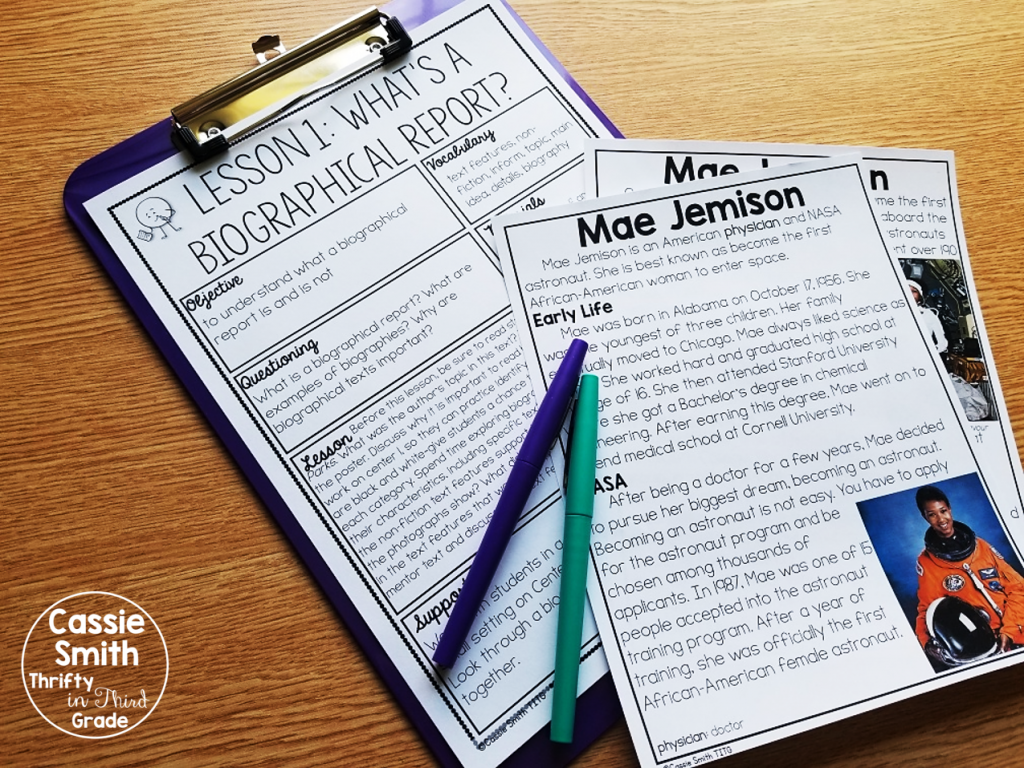
You might also like...

5 Hooks to Teach Your Students for Writing a Strong Introduction
Personal narrative writing (grades 2-5).

Using Personal Narrative Examples While Teaching Writing in 3rd, 4th, and 5th Grades
What teachers are saying, find what you need.

Let's Connect
Join my email list.
Get teaching ideas, lesson tips, and freebies sent right to your inbox!
Autobiography Writing Guide
Autobiography Examples
Last updated on: Nov 20, 2023
Autobiography Examples – Detailed Outline and Samples
By: Barbara P.
Reviewed By: Melisa C.
Published on: Mar 22, 2023

We all have stories to tell. And, for some of us, the only way we feel like we can get our story out there is by writing it down. Some people may believe that an autobiography is something only famous people write about themselves but that is not true.
In fact, anyone who has a story worth telling can write an autobiography.
If you are assigned to write an autobiography in your high school or college and you are confused about where to start, don’t panic.
You are at the right place.
Explore this detailed guide to understand the concept of writing an autobiography. It will also provide you with some great autobiography examples for a better understanding.

On this Page
What is an Autobiography?
An autobiography is a kind of the self-written story of a person's life. This type of narration has various aims and objectives that depend on the kind of writing that you decide to go with.
Moreover, it has different types. A writer can choose any of them on the basis of what he wants to include in his story.
AUTOBIOGRAPHY OUTLINE (PDF)
AUTOBIOGRAPHY TEMPLATE (PDF)
Struggling to understand the basics of autobiography? Check out this how to write an autobiography to understand the key prerequisite of autobiographies.
Autobiography Types
Below-mentioned is the four main types of autobiography. These include:
1. Traditional Autobiography – It is a complete story that covers all life experiences including birth, childhood, and adulthood. You can write it for personal use. However, if you feel that your life can be inspiring for others, you can also write it for the wider public.
2. Memoir – It focuses on describing a specific event, relationship, time period, or place that has an effect on your personality and life. For example, it may include your hometown or an important relationship.
3. Personal Essay – It is the idea of sharing your life story with the audience in a way that they feel as if they were a part of it. Similarly, it also describes two aspects including the event and how it affected the beliefs.
4. Confessional – Some people find comfort in writing about their mistakes and sins. Thus, they write this type of autobiography so that people will learn from their mistakes and avoid them.

Paper Due? Why Suffer? That's our Job!
Examples are an essential way to learn something in less time. Therefore, we have stated some examples for you to write your autobiographies. These will also help to learn about a proper autobiography template and structure.
Have a look at these autobiography examples to get a better understanding.
Cultural Autobiography Examples
CULTURAL AUTOBIOGRAPHY (PDF)
Educational Autobiography Examples for Students
EDUCATIONAL AUTOBIOGRAPHY (PDF)
Autobiography Examples For Class 6
Autobiography Examples For Grade 7
Autobiography Examples For College Students
Autobiography Examples About Yourself
Autobiography Examples Ks2
Famous Personality Autobiography
The autobiography of benjamin franklin is one example of a famous personality autobiography. Similarly, these famous autobiography examples will provide you with everything to get started with your famous personality autobiography.
FAMOUS PERSONALITY AUTOBIOGRAPHY (PDF)
Funny Autobiography
FUNNY AUTOBIOGRAPHY (PDF)
High School Autobiography
HIGH SCHOOL AUTOBIOGRAPHY (PDF)
Literary Autobiography Example
Literary Autobiography
Personal Autobiography
PERSONAL AUTOBIOGRAPHY (PDF)
Professional Autobiography
PROFESSIONAL AUTOBIOGRAPHY (PDF)
Struggling to understand the difference between memoir and autobiography? Check this guide with memoir vs autobiography examples to differentiate between the two terms.
Scientific Autobiography
SCIENTIFIC AUTOBIOGRAPHY (PDF)
Short Autobiography Examples for Students
SHORT AUTOBIOGRAPHY (PDF)
Autobiography Examples Books
Autobiography example books provide a detailed insight into the life of an individual. Through these real-life stories, readers get to know more about a person's experiences and how they overcame challenges.
Book Autobiography Sample
Spiritual Autobiography Examples
Spiritual autobiographies are a great way to reflect on one's spiritual journey and the lessons learned along the way. Here is an example to help you out.
Spiritual Autobiography Sample
The Dos and Don'ts of an Autobiography
A successful autobiography indicates the author’s ability to present a worthwhile story. There are a wide variety of things that you can talk about while writing your personal narratives.
However, the following are some dos and don'ts of writing an autobiography that will help in refining your writing skills.
Some dos of writing an autobiography are:
- Understanding the Intended Audience
There is a huge difference when you are writing an autobiography for your friends or a group of strangers. Because it requires extensive details about life events and experiences. Thus, make sure to include facts that you consider significant.
- Developing A Core Concept
It is essential to identify the central theme of your autobiography. Moreover, a well-structured outline is also a proper way of associating one event with another. It will also set the interest of the readers by keeping the story consistent from the beginning to the end.
- Do Tell the Truth
Do not portray yourself as the hero or villain of the story. Instead, tell the truth and acknowledge your mistakes by exposing your strengths and weaknesses.
- Revising and Editing
Read aloud what you have written and do some editing. Check if your ideas flow logically and look out for interrupting thoughts.
- Do Seek Feedback
Ask your friends and family to read your work and provide you with feedback. Understand the difference between fair criticism and forced judgment.
Tough Essay Due? Hire Tough Writers!
Don’ts of Writing an Autobiography
Below mentioned are some don'ts of writing an autobiography.
- Do Not Mention Unnecessary Details
Include relevant details and struggles when narrating your life story. Avoid adding unnecessary details. Instead, share the information that is directly related to your story.
- Stop Worrying About Others
Your story may contain some details that can have a negative effect on others. Do not worry about them and rearrange all the details.
Moreover, remember that you are not here to please everyone. Thus, avoid writing for a broader audience and make your story too generic and specific for the readers.
- Discuss Why Your Story Is Inspiring
If your main goal is to inspire people with your story, show them how you felt instead of telling them directly. Allow the audience to come to the conclusion through your writing style.
- Avoid Copying Someone's Story
It is a big mistake to copy someone's work to make your story compelling. Find the hook and unique points that are marketable. Also, think of all these details before you begin writing.
Autobiographies aim to educate and inform others in some ways. This blog has provided all the essential details to write an autobiography. You can generate even more samples of autobiography through our FREE AI-based paper writer .
If you are still looking up “ who can write my essay? ”, relying on a professional expert is a good option. Make sure you select a reliable and top-ranked writing service, 5StarEssays.com . We guarantee you high-quality write essay services with zero percent plagiarism.
Give us a chance and place your order now by contacting our professional writers through the live chat option.

Literature, Marketing
Dr. Barbara is a highly experienced writer and author who holds a Ph.D. degree in public health from an Ivy League school. She has worked in the medical field for many years, conducting extensive research on various health topics. Her writing has been featured in several top-tier publications.
Was This Blog Helpful?
Keep reading.
- How to Write an Autobiography - A Complete Guide

- Know the Different Types of Autobiography Here

- Autobiography Format for Students - A Detailed Guide

- Autobiography vs. Memoir: Definitions & Writing Tips

People Also Read
- descriptive essay topics
- graduation essay
- literary analysis essay writing
- research paper topics
- persuasive essay writing
Burdened With Assignments?

Advertisement
- Homework Services: Essay Topics Generator
© 2024 - All rights reserved

How to Write a Biography
Biographies are big business. Whether in book form or Hollywood biopics, the lives of the famous and sometimes not-so-famous fascinate us.
While it’s true that most biographies are about people who are in the public eye, sometimes the subject is less well-known. Primarily, though, famous or not, the person who is written about has led an incredible life.
In this article, we will explain biography writing in detail for teachers and students so they can create their own.
While your students will most likely have a basic understanding of a biography, it’s worth taking a little time before they put pen to paper to tease out a crystal-clear definition of one.

What Is a Biography?

A biography is an account of someone’s life written by someone else . While there is a genre known as a fictional biography, for the most part, biographies are, by definition, nonfiction.
Generally speaking, biographies provide an account of the subject’s life from the earliest days of childhood to the present day or, if the subject is deceased, their death.
The job of a biography is more than just to outline the bare facts of a person’s life.
Rather than just listing the basic details of their upbringing, hobbies, education, work, relationships, and death, a well-written biography should also paint a picture of the subject’s personality and experience of life.

Full Biographies
Teaching unit.
Teach your students everything they need to know about writing an AUTOBIOGRAPHY and a BIOGRAPHY.
⭐⭐⭐⭐⭐ ( 26 reviews )
Features of a Biography
Before students begin writing a biography, they’ll need to have a firm grasp of the main features of a Biography. An excellent way to determine how well they understand these essential elements is to ask them to compile a checklist like the one-blow
Their checklists should contain the items below at a minimum. Be sure to help them fill in any gaps before moving on to the writing process.
The purpose of a biography is to provide an account of someone’s life.
Biography structure.
ORIENTATION (BEGINNING) Open your biography with a strong hook to grab the reader’s attention
SEQUENCING: In most cases, biographies are written in chronological order unless you are a very competent writer consciously trying to break from this trend.
COVER: childhood, upbringing, education, influences, accomplishments, relationships, etc. – everything that helps the reader to understand the person.
CONCLUSION: Wrap your biography up with some details about what the subject is doing now if they are still alive. If they have passed away, make mention of what impact they have made and what their legacy is or will be.
BIOGRAPHY FEATURES
LANGUAGE Use descriptive and figurative language that will paint images inside your audience’s minds as they read. Use time connectives to link events.
PERSPECTIVE Biographies are written from the third person’s perspective.
DETAILS: Give specific details about people, places, events, times, dates, etc. Reflect on how events shaped the subject. You might want to include some relevant photographs with captions. A timeline may also be of use depending upon your subject and what you are trying to convey to your audience.
TENSE Written in the past tense (though ending may shift to the present/future tense)
THE PROCESS OF WRITING A BIOGRAPHY
Like any form of writing, you will find it simple if you have a plan and follow it through. These steps will ensure you cover the essential bases of writing a biography essay.
Firstly, select a subject that inspires you. Someone whose life story resonates with you and whose contribution to society intrigues you. The next step is to conduct thorough research. Engage in extensive reading, explore various sources, watch documentaries, and glean all available information to provide a comprehensive account of the person’s life.
Creating an outline is essential to organize your thoughts and information. The outline should include the person’s early life, education, career, achievements, and any other significant events or contributions. It serves as a map for the writing process, ensuring that all vital information is included.
Your biography should have an engaging introduction that captivates the reader’s attention and provides background information on the person you’re writing about. It should include a thesis statement summarising the biography’s main points.
Writing a biography in chronological order is crucial . You should begin with the person’s early life and move through their career and achievements. This approach clarifies how the person’s life unfolded and how they accomplished their goals.
A biography should be written in a narrative style , capturing the essence of the person’s life through vivid descriptions, anecdotes, and quotes. Avoid dry, factual writing and focus on creating a compelling narrative that engages the reader.
Adding personal insights and opinions can enhance the biography’s overall impact, providing a unique perspective on the person’s achievements, legacy, and impact on society.
Editing and proofreading are vital elements of the writing process. Thoroughly reviewing your biography ensures that the writing is clear, concise, and error-free. You can even request feedback from someone else to ensure that it is engaging and well-written.
Finally, including a bibliography at the end of your biography is essential. It gives credit to the sources that were used during research, such as books, articles, interviews, and websites.
Tips for Writing a Brilliant Biography
Biography writing tip #1: choose your subject wisely.
There are several points for students to reflect on when deciding on a subject for their biography. Let’s take a look at the most essential points to consider when deciding on the subject for a biography:
Interest: To produce a biography will require sustained writing from the student. That’s why students must choose their subject well. After all, a biography is an account of someone’s entire life to date. Students must ensure they choose a subject that will sustain their interest throughout the research, writing, and editing processes.
Merit: Closely related to the previous point, students must consider whether the subject merits the reader’s interest. Aside from pure labors of love, writing should be undertaken with the reader in mind. While producing a biography demands sustained writing from the author, it also demands sustained reading from the reader.
Therefore, students should ask themselves if their chosen subject has had a life worthy of the reader’s interest and the time they’d need to invest in reading their biography.
Information: Is there enough information available on the subject to fuel the writing of an entire biography? While it might be a tempting idea to write about a great-great-grandfather’s experience in the war. There would be enough interest there to sustain the author’s and the reader’s interest, but do you have enough access to information about their early childhood to do the subject justice in the form of a biography?
Biography Writing Tip #2: R esearch ! Research! Research!
While the chances are good that the student already knows quite a bit about the subject they’ve chosen. Chances are 100% that they’ll still need to undertake considerable research to write their biography.
As with many types of writing , research is an essential part of the planning process that shouldn’t be overlooked. If students wish to give as complete an account of their subject’s life as possible, they’ll need to put in the time at the research stage.
An effective way to approach the research process is to:
1. Compile a chronological timeline of the central facts, dates, and events of the subject’s life
2. Compile detailed descriptions of the following personal traits:
- Physical looks
- Character traits
- Values and beliefs
3. Compile some research questions based on different topics to provide a focus for the research:
- Childhood : Where and when were they born? Who were their parents? Who were the other family members? What education did they receive?
- Obstacles: What challenges did they have to overcome? How did these challenges shape them as individuals?
- Legacy: What impact did this person have on the world and/or the people around them?
- Dialogue & Quotes: Dialogue and quotations by and about the subject are a great way to bring color and life to a biography. Students should keep an eagle eye out for the gems that hide amid their sources.
As the student gets deeper into their research, new questions will arise that can further fuel the research process and help to shape the direction the biography will ultimately go in.
Likewise, during the research, themes will often begin to suggest themselves. Exploring these themes is essential to bring depth to biography, but we’ll discuss this later in this article.
Research Skills:
Researching for biography writing is an excellent way for students to hone their research skills in general. Developing good research skills is essential for future academic success. Students will have opportunities to learn how to:
- Gather relevant information
- Evaluate different information sources
- Select suitable information
- Organize information into a text.
Students will have access to print and online information sources, and, in some cases, they may also have access to people who knew or know the subject (e.g. biography of a family member).
These days, much of the research will likely take place online. It’s crucial, therefore, to provide your students with guidance on how to use the internet safely and evaluate online sources for reliability. This is the era of ‘ fake news ’ and misinformation after all!
COMPLETE TEACHING UNIT ON INTERNET RESEARCH SKILLS USING GOOGLE SEARCH

Teach your students ESSENTIAL SKILLS OF THE INFORMATION ERA to become expert DIGITAL RESEARCHERS.
⭐How to correctly ask questions to search engines on all devices.
⭐ How to filter and refine your results to find exactly what you want every time.
⭐ Essential Research and critical thinking skills for students.
⭐ Plagiarism, Citing and acknowledging other people’s work.
⭐ How to query, synthesize and record your findings logically.
BIOGRAPHY WRITING Tip #3: Find Your Themes In Biography Writing
Though predominantly a nonfiction genre, the story still plays a significant role in good biography writing. The skills of characterization and plot structuring are transferable here. And, just like in fiction, exploring themes in a biographical work helps connect the personal to the universal. Of course, these shouldn’t be forced; this will make the work seem contrived, and the reader may lose faith in the truthfulness of the account. A biographer needs to gain and maintain the trust of the reader.
Fortunately, themes shouldn’t need to be forced. A life well-lived is full of meaning, and the themes the student writer is looking for will emerge effortlessly from the actions and events of the subject’s life. It’s just a case of learning how to spot them.
One way to identify the themes in a life is to look for recurring events or situations in a person’s life. These should be apparent from the research completed previously. The students should seek to identify these patterns that emerge in the subject’s life. For example, perhaps they’ve had to overcome various obstacles throughout different periods of their life. In that case, the theme of overcoming adversity is present and has been identified.
Usually, a biography has several themes running throughout, so be sure your students work to identify more than one theme in their subject’s life.
BIOGRAPHY WRITING Tip: #4 Put Something of Yourself into the Writing
While the defining feature of a biography is that it gives an account of a person’s life, students must understand that this is not all a biography does. Relating the facts and details of a subject’s life is not enough. The student biographer should not be afraid to share their thoughts and feelings with the reader throughout their account of their subject’s life.
The student can weave some of their personality into the fabric of the text by providing commentary and opinion as they relate the events of the person’s life and the wider social context at the time. Unlike the detached and objective approach we’d expect to find in a history textbook, in a biography, student-writers should communicate their enthusiasm for their subject in their writing.
This makes for a more intimate experience for the reader, as they get a sense of getting to know the author and the subject they are writing about.
Biography Examples For Students
- Year 5 Example
- Year 7 Example
- Year 9 Example
“The Rock ‘n’ Roll King: Elvis Presley”
Elvis Aaron Presley, born on January 8, 1935, was an amazing singer and actor known as the “King of Rock ‘n’ Roll.” Even though he’s been dead for nearly 50 years, I can’t help but be fascinated by his incredible life!
Elvis grew up in Tupelo, Mississippi, in a tiny house with his parents and twin brother. His family didn’t have much money, but they shared a love for music. Little did they know Elvis would become a music legend!
When he was only 11 years old, Elvis got his first guitar. He taught himself to play and loved singing gospel songs. As he got older, he started combining different music styles like country, blues, and gospel to create a whole new sound – that’s Rock ‘n’ Roll!
In 1954, at the age of 19, Elvis recorded his first song, “That’s All Right.” People couldn’t believe how unique and exciting his music was. His famous hip-swinging dance moves also made him a sensation!
Elvis didn’t just rock the music scene; he also starred in movies like “Love Me Tender” and “Jailhouse Rock.” But fame came with challenges. Despite facing ups and downs, Elvis kept spreading happiness through his music.

Tragically, Elvis passed away in 1977, but his music and charisma live on. Even today, people worldwide still enjoy his songs like “Hound Dog” and “Can’t Help Falling in Love.” Elvis Presley’s legacy as the King of Rock ‘n’ Roll will live forever.
Long Live the King: I wish I’d seen him.
Elvis Presley, the Rock ‘n’ Roll legend born on January 8, 1935, is a captivating figure that even a modern-day teen like me can’t help but admire. As I delve into his life, I wish I could have experienced the magic of his live performances.
Growing up in Tupelo, Mississippi, Elvis faced challenges but found solace in music. At 11, he got his first guitar, a symbol of his journey into the world of sound. His fusion of gospel, country, and blues into Rock ‘n’ Roll became a cultural phenomenon.
The thought of being in the audience during his early performances, especially when he recorded “That’s All Right” at 19, sends shivers down my spine. Imagining the crowd’s uproar and feeling the revolutionary energy of that moment is a dream I wish I could have lived.
Elvis wasn’t just a musical prodigy; he was a dynamic performer. His dance moves, the embodiment of rebellion, and his roles in films like “Love Me Tender” and “Jailhouse Rock” made him a true icon.
After watching him on YouTube, I can’t help but feel a little sad that I’ll never witness the King’s live performances. The idea of swaying to “Hound Dog” or being enchanted by “Can’t Help Falling in Love” in person is a missed opportunity. Elvis may have left us in 1977, but he was the king of rock n’ roll. Long live the King!
Elvis Presley: A Teen’s Take on the Rock ‘n’ Roll Icon”
Elvis Presley, born January 8, 1935, was a revolutionary force in the music world, earning his title as the “King of Rock ‘n’ Roll.” Exploring his life, even as a 16-year-old today, I’m captivated by the impact he made.
Hailing from Tupelo, Mississippi, Elvis grew up in humble beginnings, surrounded by the love of his parents and twin brother. It’s inspiring to think that, despite financial challenges, this young man would redefine the music scene.
At 11, Elvis got his first guitar, sparking a self-taught journey into music. His early gospel influences evolved into a unique fusion of country, blues, and gospel, creating the electrifying genre of Rock ‘n’ Roll. In 1954, at only 19, he recorded “That’s All Right,” marking the birth of a musical legend.
Elvis wasn’t just a musical innovator; he was a cultural phenomenon. His rebellious dance moves and magnetic stage presence challenged the norms. He transitioned seamlessly into acting, starring in iconic films like “Love Me Tender” and “Jailhouse Rock.”

However, fame came at a cost, and Elvis faced personal struggles. Despite the challenges, his music continued to resonate. Even now, classics like “Hound Dog” and “Can’t Help Falling in Love” transcend generations.
Elvis Presley’s impact on music and culture is undeniable. He was known for his unique voice, charismatic persona, and electrifying performances. He sold over one billion records worldwide, making him one of the best-selling solo artists in history. He received numerous awards throughout his career, including three Grammy Awards and the Grammy Lifetime Achievement Award.
Elvis’s influence can still be seen in today’s music. Many contemporary artists, such as Bruno Mars, Lady Gaga, and Justin Timberlake, have cited Elvis as an inspiration. His music continues to be featured in movies, TV shows, and commercials.
Elvis left us in 1977, but his legacy lives on. I appreciate his breaking barriers and fearlessly embracing his artistic vision. Elvis Presley’s impact on music and culture is timeless, a testament to the enduring power of his artistry. His music has inspired generations and will continue to do so for many years to come.

Teaching Resources
Use our resources and tools to improve your student’s writing skills through proven teaching strategies.
BIOGRAPHY WRITING TEACHING IDEAS AND LESSONS
We have compiled a sequence of biography-related lessons or teaching ideas that you can follow as you please. They are straightforward enough for most students to follow without further instruction.
BIOGRAPHY LESSON IDEA # 1:
This session aims to give students a broader understanding of what makes a good biography.
Once your students have compiled a comprehensive checklist of the main features of a biography, allow them to use it to assess some biographies from your school library or on the internet using the feature checklist.
When students have assessed a selection of biographies, take some time as a class to discuss them. You can base the discussion around the following prompts:
- Which biographies covered all the criteria from their checklist?
- Which biographies didn’t?
- Which biography was the most readable in terms of structure?
- Which biography do you think was the least well-structured? How would you improve this?
Looking at how other writers have interpreted the form will help students internalize the necessary criteria before attempting to produce a biography. Once students have a clear understanding of the main features of the biography, they’re ready to begin work on writing a biography.
When the time does come to put pen to paper, be sure they’re armed with the following top tips to help ensure they’re as well prepared as possible.
BIOGRAPHY LESSON IDEA # 2:
This session aims to guide students through the process of selecting the perfect biography subject.
Instruct students to draw up a shortlist of three potential subjects for the biography they’ll write.
Using the three criteria mentioned in the writing guide (Interest, Merit, and Information), students award each potential subject a mark out of 5 for each of the criteria. In this manner, students can select the most suitable subject for their biography.
BIOGRAPHY LESSON IDEA # 3:
This session aims to get students into the researching phase, then prioritise and organise events chronologically.
Students begin by making a timeline of their subject’s life, starting with their birth and ending with their death or the present day. If the student has yet to make a final decision on the subject of their biography, a family member will often serve well for this exercise as a practice exercise.
Students should research and gather the key events of the person’s life, covering each period of their life from when they were a baby, through childhood and adolescence, right up to adulthood and old age. They should then organize these onto a timeline. Students can include photographs with captions if they have them.
They can present these to the class when they have finished their timelines.
BIOGRAPHY LESSON IDEA # 4:
Instruct students to look over their timeline, notes, and other research. Challenge them to identify three patterns that repeat throughout the subject’s life and sort all the related events and incidents into specific categories.
Students should then label each category with a single word. This is the thematic concept or the broad general underlying idea. After that, students should write a sentence or two expressing what the subject’s life ‘says’ about that concept.
This is known as the thematic statement . With the thematic concepts and thematic statements identified, the student now has some substantial ideas to explore that will help bring more profound meaning and wider resonance to their biography.
BIOGRAPHY LESSON IDEA # 5:
Instruct students to write a short objective account of an event in their own life. They can write about anyone from their past. It needn’t be more than a couple of paragraphs, but the writing should be strictly factual, focusing only on the objective details of what happened.
Once they have completed this, it’s time to rewrite the paragraph, but they should include some opinion and personal commentary this time.
The student here aims to inject some color and personality into their writing, to transform a detached, factual account into a warm, engaging story.
A COMPLETE UNIT ON TEACHING BIOGRAPHIES

Teach your students to write AMAZING BIOGRAPHIES & AUTOBIOGRAPHIES using proven RESEARCH SKILLS and WRITING STRATEGIES .
- Understand the purpose of both forms of biography.
- Explore the language and perspective of both.
- Prompts and Challenges to engage students in writing a biography.
- Dedicated lessons for both forms of biography.
- Biographical Projects can expand students’ understanding of reading and writing a biography.
- A COMPLETE 82-PAGE UNIT – NO PREPARATION REQUIRED.

FREE Biography Writing Graphic Organizer
Use this valuable tool in the research and writing phases to keep your students on track and engaged.
WRITING CHECKLIST & RUBRIC BUNDLE

⭐⭐⭐⭐⭐ (92 Reviews)
To Conclude
By this stage, your students should have an excellent technical overview of a biography’s essential elements.
They should be able to choose their subject in light of how interesting and worthy they are, as well as give consideration to the availability of information out there. They should be able to research effectively and identify emerging themes in their research notes. And finally, they should be able to bring some of their personality and uniqueness into their retelling of the life of another.
Remember that writing a biography is not only a great way to develop a student’s writing skills; it can be used in almost all curriculum areas. For example, to find out more about a historical figure in History, to investigate scientific contributions to Science, or to celebrate a hero from everyday life.
Biography is an excellent genre for students to develop their writing skills and to find inspiration in the lives of others in the world around them.
HOW TO WRITE A BIOGRAPHY TUTORIAL VIDEO

OTHER GREAT ARTICLES RELATED TO BIOGRAPHY WRITING

How to write an Autobiography

How to Write a Historical Recount Text

15 Awesome Recount & Personal Narrative Topics

Personal Narrative Writing Guide

Reading & Math for K-5
- Kindergarten
- Learning numbers
- Comparing numbers
- Place Value
- Roman numerals
- Subtraction
- Multiplication
- Order of operations
- Drills & practice
- Measurement
- Factoring & prime factors
- Proportions
- Shape & geometry
- Data & graphing
- Word problems
- Children's stories
- Leveled Stories
- Context clues
- Cause & effect
- Compare & contrast
- Fact vs. fiction
- Fact vs. opinion
- Main idea & details
- Story elements
- Conclusions & inferences
- Sounds & phonics
- Words & vocabulary
- Reading comprehension
- Early writing
- Numbers & counting
- Simple math
- Social skills
- Other activities
- Dolch sight words
- Fry sight words
- Multiple meaning words
- Prefixes & suffixes
- Vocabulary cards
- Other parts of speech
- Punctuation
- Capitalization
- Narrative writing
- Opinion writing
- Informative writing
- Cursive alphabet
- Cursive letters
- Cursive letter joins
- Cursive words
- Cursive sentences
- Cursive passages
- Grammar & Writing
Breadcrumbs
- Biographies
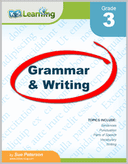
Download & Print Only $6.49
Biography writing
Research and write.
Students research and write about an individual. The emphasis is on researching and planning the essay, prior to writing the text.

Barack Obama:
Lionel Messi:
Taylor Swift:
Walt Disney:

These worksheets are available to members only.
Join K5 to save time, skip ads and access more content. Learn More
What is K5?
K5 Learning offers free worksheets , flashcards and inexpensive workbooks for kids in kindergarten to grade 5. Become a member to access additional content and skip ads.
Our members helped us give away millions of worksheets last year.
We provide free educational materials to parents and teachers in over 100 countries. If you can, please consider purchasing a membership ($24/year) to support our efforts.
Members skip ads and access exclusive features.
Learn about member benefits
This content is available to members only.
- Forgot Password?

IMAGES
VIDEO
COMMENTS
Make sure you use words that even a four-year-old can understand. These words should be short and widely used. For example, when you work on an autobiography for children, it is better to write 'good' instead of 'magnificent.'. ️. Use short sentences. Keep the limit of about 15 words in a sentence.
View the BIOGRAPHIES for Grade 3 collection on Epic plus over 40,000 of the best books & videos for kids. BIOGRAPHIES for Grade 3 Children's Book Collection | Discover Epic Children's Books, Audiobooks, Videos & More
12 Biographies, Autobiographies, and Memoirs for 3rd, 4th, and 5th Grade Students. Anne Frank: The Diary of a Young Girl by Anne Frank, B.M. Mooyaart (Translator), Eleanor Roosevelt (Introduction) It is July 6, 1942, the setting is Amsterdam, and Anne Frank has just received a diary for her birthday. The rest is history.
Reaching for the Moon: The Autobiography of NASA Mathematician Katherine Johnson by. Katherine G. Johnson. 4.34 avg rating — 1,453 ratings. score: 100, and 1 person voted ... 3.99 avg rating — 606 ratings. score: 81, and 1 person voted ...
avg rating 3.21 — 14 ratings — published 2007. Books shelved as 3rd-grade-biography-autobiography: Thomas Edison: A Brilliant Inventor by Lisa DeMauro, Eleanor by Barbara Cooney, On a Beam of Light: A...
3 | Super hero autobiography example. Head on over to Literacy Wagoll's Biographies and Autobiographies section for a collection of free example texts, including this superhero autobiography.. No doubt your students are more than familiar with comic book movies and have seen countless origin stories, so they should be able to write one for their own created superhero.
Talk about what they usually see on the cover of a book-the title, the author's name, and a photograph or illustration. You might bring in some autobiographies or biographies to use as examples. You can also show them the cover you have created for your own autobiography. 5. Distribute a cover sheet to each student. Have them create covers ...
Twinkl Australia 3 - 4 Australian Curriculum Resources English Literacy Writing Writing Frames and Templates. This Autobiography Template is a fantastic teaching tool to help support middle and upper primary students as they learn to write an autobiographical text.
This Beyond autobiography resource pack gives your students plenty to think about. It includes a sample of an autobiography for them to read, and then to dissect and study. There are versions for your students to annotate themselves, along with a display poster to remind them of the important parts of the lesson.
Autobiographies tell the stories of their authors and are considered as a literary genre. Twinkl Malta Ages 7-11 English Writing Non-Fiction Personal Writing. This Autobiography Template is a fantastic teaching tool to help support middle and upper primary students as they learn to write an autobiography text.
Grade 3 . 9 - 10 years old . Grade 4 . 10 - 11 years old . Grade 5 . 11 - 14 years old . Grades 6 - 8 ... autobiography example . Autobiography Planning Sheet. Features of an Autobiography Word Mat. Autobiography Project Booklet. Autobiography and Biography PowerPoint.
Learn the life story and biography of influencial people: US Presidents, World Leaders, Inventors, Women, Artists, Civil Rights heroes. History Biography Geography Science Games. Search Ducksters: Biographies. Biographies by Date Biographies Alphabetical. Pick the person or subject below to view biography or list of biographies: ...
Famous Autobiography Examples. Autobiographical essays are usually about famous people or historical figures. Just as a renowned autobiography of Benjamin Franklin tells us about his life, his unfinished records, his accomplishments, etc. Below are some examples of famous autobiographies for your better understanding:
Autobiography Definition, Examples, and Writing Guide. As a firsthand account of the author's own life, an autobiography offers readers an unmatched level of intimacy. Learn how to write your first autobiography with examples from MasterClass instructors.
4.7 (15 Reviews) Artist Fact Sheet Barbara Hepworth. Artist Fact Sheet William Morris. Hillary Clinton Biography. Third Grade Buzz Aldrin Fact File. 5.0 (1 Review) Artist Fact Sheet Michelle Reader. Artist Fact Sheet Eva Rothschild. Third Grade Amelia Earhart Reading Comprehension Activity.
Writing an autobiography? A great task to set children and encourage them to write, particularly for distance, home or online learning. The powerpoint explains what the children need to write about and includes a planning mind map. There is an example autobiography to help inspire children as well as a document to help structure their ...
Crafting the Body Paragraphs of the Biography Report. When teaching your students to write biography reports, it is important to explain to them what the body paragraphs should include. The body paragraphs should include the major events in the person's life. Read over the body paragraphs from your mentor text and discuss what was included ...
By reading these biographies, second-grade and third-grade students learn about the famous person through a fun, easy-to-read passage. Students can also use the QR Codes for additional biography research. Included are comprehension activities that support a sequence of events and categorizing facts, as well as a simple biography report.
Donald Trump. This biography details the 45th President of the United States' life, including his father's success in real estate, his three marriages, and his journey to becoming president. This biography can be used for your social studies lessons or simply to educate your children about the current president.
Famous Personality Autobiography. The autobiography of benjamin franklin is one example of a famous personality autobiography. Similarly, these famous autobiography examples will provide you with everything to get started with your famous personality autobiography. It elaborates the family, education, and career details of Wolfgang Ketterle.
BIOGRAPHY WRITING Tip: #4 Put Something of Yourself into the Writing. While the defining feature of a biography is that it gives an account of a person's life, students must understand that this is not all a biography does. Relating the facts and details of a subject's life is not enough.
The emphasis is on researching and planning the essay, prior to writing the text. Classmate: Worksheet #1. Barack Obama: Worksheet #2. Lionel Messi: Worksheet #3. Taylor Swift: Worksheet #4.
34 Best Autobiography Examples - Essay Templates. An autobiography is a form of narration about a person's life written by that individual. It is derived from a Greek word that means self-life-writing. The author of an autobiography provides a first-person account of his/her life. The details of the autobiography must be kept factual.